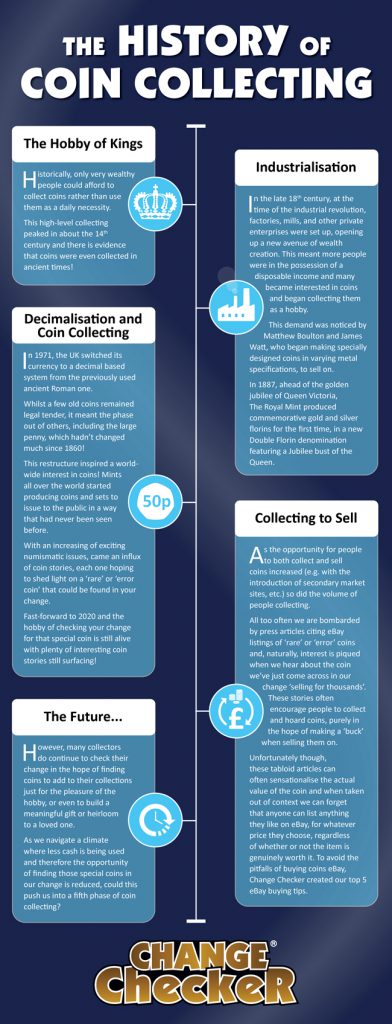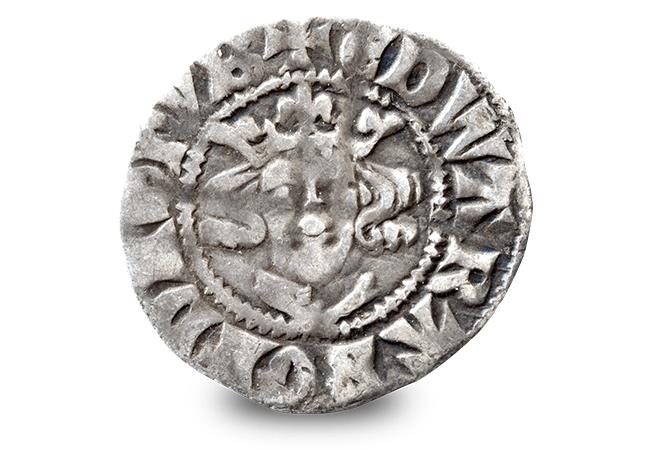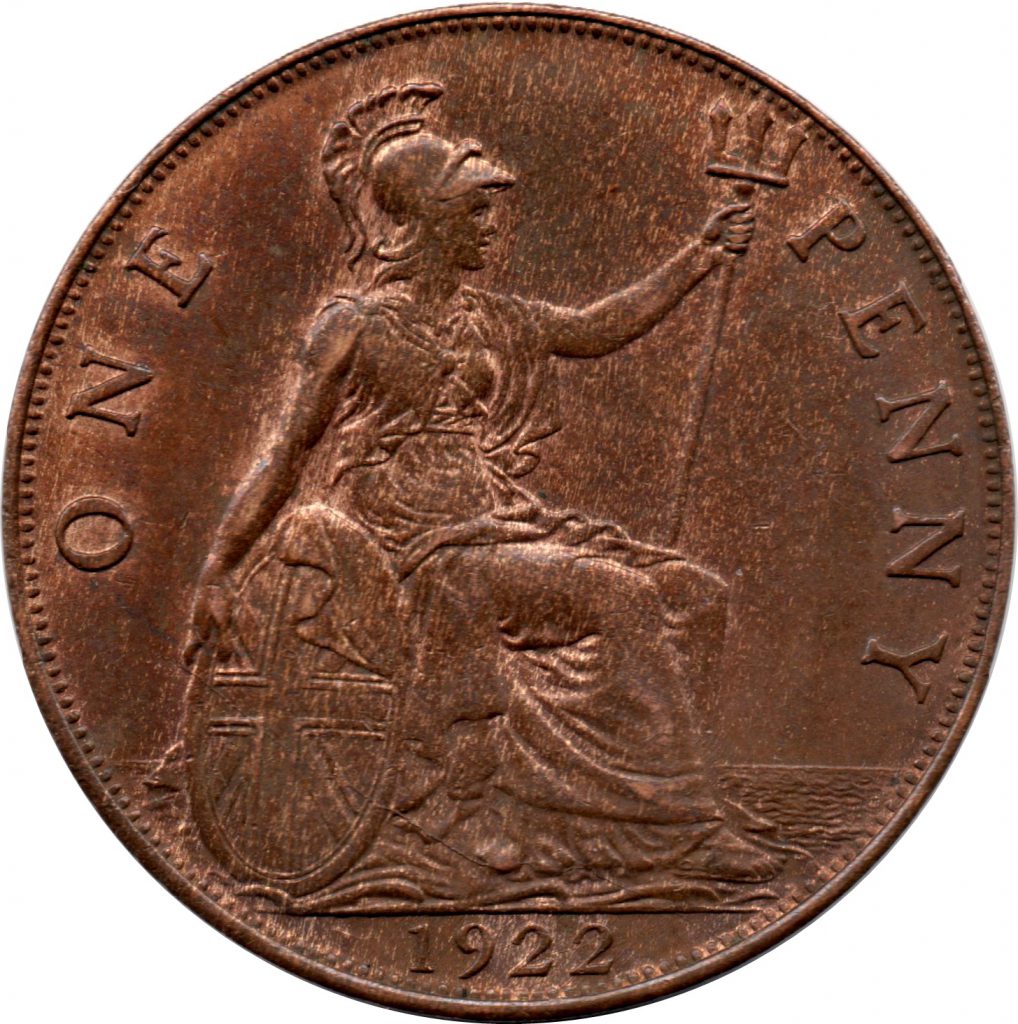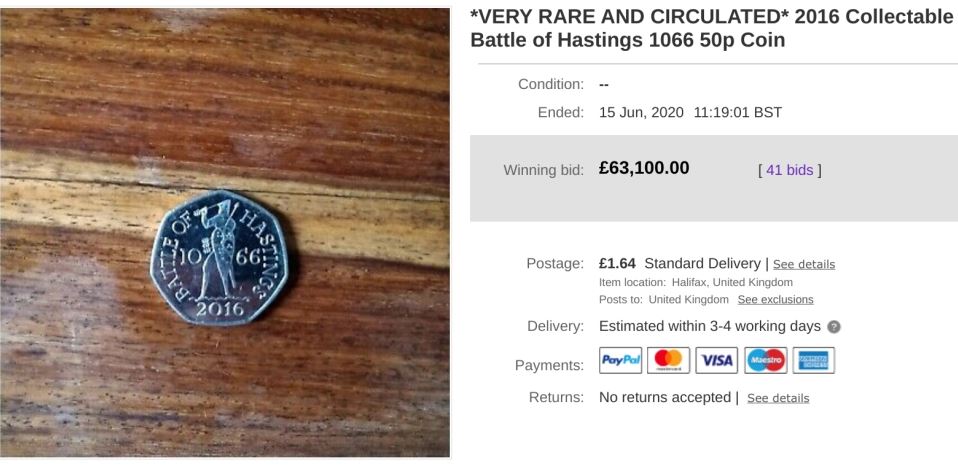Posts Tagged ‘British History’
The History of Coin Collecting
Coin collecting is a hobby that spans across generations, but did you know it also spans across centuries?
In this blog, we talk you through the different phases of coin collecting!

The Hobby of Kings
Historically, only very wealthy people or royals could afford to collect coins rather than use them as a daily necessity.

This high-level collecting peaked in about the 14th century and there is evidence that coins were even collected in ancient times!
Industrialisation
In the late 18th century, at the time of the industrial revolution, factories, mills, and other private enterprises were set up, opening up a new avenue of wealth creation. This meant more people were in possession of a disposable income and many became interested in coins and began collecting them as a hobby.
This demand was noticed by Matthew Boulton and James Watt, who began making specially designed coins in various metal specifications, to sell on.
In 1887, ahead of the golden jubilee of Queen Victoria, The Royal Mint produced commemorative gold and silver florins for the first time, a new Double Florin denomination featuring a Jubilee bust of the Queen.

This was to start a tradition of producing ‘special’ coins to mark particular historic or royal anniversaries that carried through to the 20th century.
Decimalisation and Coin Collecting
In 1971, the UK switched its currency to a decimal based system from the previously used system dating back to ancient Roman times.
Whilst a few old coins remained legal tender, it saw the phase out of others, including the large penny, which hadn’t changed much since 1860!

This restructure inspired a world-wide interest in coins! Mints all over the world started producing coins and sets to issue to the public in a way that had never been seen before.
With an increasing of exciting numismatic issues, came an influx of coin stories, each one hoping to shed light on a ‘rare’ or ‘error coin’ that could be found in your change.
Fast-forward to 2020 and the hobby of checking your change for that special coin is still alive with plenty of interesting coin stories still surfacing!
Collecting to Sell
As the opportunity for people to both collect and sell coins increased (e.g. with the introduction of secondary market sites, etc.) so did the volume of people collecting.
All too often we are bombarded by press articles citing eBay listings of ‘rare’ or ‘error’ coins and, naturally, interest is piqued when we hear about the coin we’ve just come across in our change ‘selling for thousands’. These stories often encourage people to collect and hoard coins, purely in the hope of making a ‘buck’ when selling them on.
Unfortunately though, these tabloid articles can often sensationalise the actual value of the coin and when taken out of context we can forget that anyone can list anything they like on eBay, for whatever price they choose, regardless of whether or not the item is genuinely worth it. To avoid the pitfalls of buying coins eBay, Change Checker created our top 5 eBay buying tips.

However, many collectors do continue to check their change in the hope of finding coins to add to their collections just for the pleasure of the hobby, or even to build a meaningful gift or heirloom to a loved one.
As we navigate a climate where less cash is being used and therefore the opportunity of finding those special coins in our change is reduced, could this push us into a fifth phase of coin collecting?
Secure the History of Britain in Coins Collecting Album!
Secure one to your collection today by clicking here >>
The five 50p coins RE-ISSUED to celebrate British Military History
As many collectors will know, 2019 marks the 50th Anniversary of the 50p coin.
Since its issue in 1969, the world’s first seven-sided coin has become a huge favourite with collectors and has served as a canvas to commemorate some of the most iconic moments in British Military history.
As we mark a milestone year for this iconic coin, The Royal Mint’s celebration continues as they reissue five of the most important 50p coins celebrating British Military history!
These five 50p coins, pieced together for the first time, mark a rare milestone moment for British Coinage. Not to mention the set also includes the 1994 D-Day 50p re-issued in the NEW 50p specifications for the first time ever!
Earlier in the year, the Base Proof, Silver Proof and Gold Proof British Culture 50p sets sold-out within just TWO HOURS of going on sale. The Brilliant Uncirculated set released just a short while later also saw an overwhelming response from collectors.
Find out the story of each of the coins featured in the British Military 50p Set below…
Victoria Cross Medal 50p

The Victoria Cross is the highest award for gallantry that a British serviceman can achieve. A recommendation for the Victoria Cross is normally issued by an officer at regimental level and has to be supported by three witnesses.
This coin was originally issued in 2006 to mark the 150th Anniversary of the Victoria Cross.
Depicting the obverse and reverse of a Victoria Cross medal, the design by Claire Aldridge carefully details the Cross pattée with a crown and Lion as on the medal itself.
Victoria Cross Soldier 50p

The Victoria Cross Award was introduced in 1856 by Queen Victoria to honour acts of the Crimean War.
Since then, two-thirds of all awards won have been presented by the British Monarch at investitures which are usually held at Buckingham Palace.
To date, the medal has been awarded 1,358 times. A large number of these were awarded during the World Wars: 634 in World War One and 182 awarded in World War Two.
Initially issued in 2006 to mark 150 years of the Victoria Cross Award, this coin features a soldier carrying a wounded comrade with an outline of the Victoria Cross as designed by Clive Duncan.
Battle of Hastings 50p

The Battle of Hastings was fought on the 14th of October 1066 between the French Army, led by Duke William II, and the English Army led by King Harold.
King Harold was eventually defeated by William who then became known as William the Conqueror; he was crowned the first Norman King of Great Britain.
Issued in 2016 to mark 950 years since this legendary battle, the reverse design of this 50p by John Bergdahl was inspired by the Bayeux Tapestry.
Battle of Britain 50p

The Battle of Britain was an intense air battle fought mainly throughout the summer of 1940 between Germany and Britain.
The name for the conflict was derived from a Winston Churchill speech in which he said “The Battle of France is over. I expect the Battle of Britain is about to begin.”
Marking the 70th Anniversary of the Battle of Britain this coin was first issued in 2015. The reverse design, by Gary Breeze, depicts three airmen running to their planes with enemy aircraft overhead.
D-Day Landings 50p

On 6th June 1944 a mighty alliance of British, American and Commonwealth armed forces crossed from England to Normandy and began assault on German forces.
It was the largest seaborne invasion in history and began the liberation of German-occupied France, laying the foundations for the Allied victory of World War Two.
A timeless tribute to the thousands of Allied troops who fought tirelessly in the War, this 50p coin was issued in 1994 to commemorate 50 years since D-Day.
Originally struck as a large 50p in the pre-1997 specifications this is the first time ever this D-Day 50p coin has been issued in the new 50p dimensions!
The reverse of the coin was designed by John Mills and represents the D-Day Landings with the Allied invasion force heading for Normandy filling the sea and sky.
We are very excited to see these coins being re-issued as a complete set for the first time – especially the 1994 D-Day 50p in the new specifications!
Following the popularity of the re-issued British Culture 50p set earlier in the year, we expect this set to be equally as sought-after.
What coin are you most looking forward to seeing?
Secure your 50th Anniversary of the 50p Military CERTIFIED BU Set
Own the BRAND NEW 50th Anniversary of the 50p Military Set for JUST £22.50 (+ p&p).
50 years of The Royal Mint at Llantrisant… The move to decimalisation
Standing strong for over 1,100 years throughout Britain’s wars, political upheavals, social and economic progress and technological and scientific advances, The Royal Mint’s history can be traced back through our country’s coinage.
But it was on the 17th of December 50 years ago that The Queen herself opened the new site for The Royal Mint, which was moved to a purpose-built site in Llantrisant following 157 years at Tower Hill, London.
This was the first time since its inception that The Royal Mint had been based outside of London, and marked an incredibly important moment in the history of our coins.

The Queen opening the new Royal Mint in Wales. Credit: royalmintmuseum.org.uk
The move to Llantrisant
In 1966 it was announced that Britain would adopt a new decimal currency. This meant that hundreds of millions of new coins would need striking and Tower Hill simply didn’t have enough space to cope with this demand and so the decision was made to find a new location for The Royal Mint.
Llantrisant made it onto the shortlist of the top 7 locations, and as James Callaghan (Chancellor of the Exchequer, Master of the Mint and an MP for Cardiff) supported a move to Wales, Llantrisant was chosen for the big move.

Staff from Tower Hill visiting the new Royal Mint site in Llantrisant. Credit: royalmintmuseum.org.uk
Britain’s new Mint
The announcement was made in 1967 and construction soon began on the new site. For the Llantrisant area, the move meant more work and a regeneration of the town, as well as adding to the sense of history and tradition. It was estimated that the move would provide 10,000 jobs to South Wales.
It was in 1968 that the site was officially opened by Her Majesty The Queen when she switched on the coining presses to begin production of decimal bronze coins.
Llantrisant was built to house the most advanced coining machinery in the world and have a larger capacity than any other mint in Europe, necessary to cope with the amount of new coinage needed.
When the site opened, the circulating coin presses could strike up to 200 coins per minute, however the latest generation of presses today strike around 750 coins per minute!
Decimalisation of Britain’s coins
The 15th of February 1971 is known as the day that Britain “went decimal”.
Whilst this was the official ‘Decimal Day’, three years before this, the new 5p and 10p coins were actually introduced. These coins were the same size and value as the existing one and two shilling coins to make the transition easier for the British public.
It was in 1969 that the first seven sided coin – the 50p – was introduced to replace the 10-shilling note as a more economical alternative and then finally, on Monday 15 February 1971, the transition was complete when the half penny, 1p and 2p coins were also introduced.
The new Mint at Llantrisant successfully transformed hundreds of years of everyday currency from 12 pennies to the shilling and 20 shillings to the pound, to the new pound made from 100 new pence.

Royal Mint coin production plant. Credit: dailymail.co.uk
Today the Royal Mint is the market leader and the largest single supplier of plated coins and blanks in Europe. They can produce 90 million coins and blanks a week – that’s almost 5 billion coins a year!
And all this has been made possible thanks to the advanced facilities at Llantrisant, as pictured above, without which the move to decimal coinage simply wouldn’t have been possible.
Own this Historic Royal Mint anniversary DateStamp™
To mark the move of The Royal Mint to Llandistrant, you have the opportunity to own the Royal Mint in Wales 50th Anniversary DateStampTM.
Featuring the 2016 Wales £20 coin with the iconic Welsh dragon design, and postmarked 17th December 2018, exactly 50 years since The Royal Mint moved to Wales.



